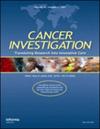基于 NGS 的组织-血液 TMB 比较和血液-TMB 监测在同时接受化疗放疗的 III 期非小细胞肺癌中的应用。
IF 1.8
4区 医学
Q3 ONCOLOGY
引用次数: 0
摘要
在这项研究中,我们分析了同时接受放化疗的局部晚期非小细胞肺癌(LA-NSCLC)患者的血液TMB(b-TMB)及其动态变化。15例患者的基线组织TMB和血液TMB显示出很强的正相关性(Pearson correlation = 0.937),几乎所有的突变在后期治疗过程中都明显减少,表明存在治疗相关反应。这项研究表明,在LA-NSCLC患者中,b-TMB是一种可靠的生物标志物,对其进行动态监测有助于区分哪些患者可能从综合免疫疗法中获益最多。本文章由计算机程序翻译,如有差异,请以英文原文为准。
NGS-based Tissue-Blood TMB Comparison and Blood-TMB Monitoring in Stage-III Non-Small Cell Lung Cancer Treated with Concurrent Chemoradiotherapy.
In this study, we analyzed the blood-based TMB (b-TMB) and its dynamic changes in patients with locally advanced non-small cell lung cancer (LA-NSCLC) who received concurrent chemoradiotherapy. Baseline tissue and blood TMB from 15 patients showed a strong positive correlation (Pearson correlation = 0.937), and nearly all mutations were markedly reduced in the later course of treatment, indicating a treatment-related response. This study suggests that in patients with LA-NSCLC, b-TMB is a reliable biomarker, and its dynamic monitoring can help distinguish patients who might benefit most from the consolidated immunotherapy.
求助全文
通过发布文献求助,成功后即可免费获取论文全文。
去求助
来源期刊

Cancer Investigation
医学-肿瘤学
CiteScore
3.80
自引率
4.20%
发文量
71
审稿时长
8.5 months
期刊介绍:
Cancer Investigation is one of the most highly regarded and recognized journals in the field of basic and clinical oncology. It is designed to give physicians a comprehensive resource on the current state of progress in the cancer field as well as a broad background of reliable information necessary for effective decision making. In addition to presenting original papers of fundamental significance, it also publishes reviews, essays, specialized presentations of controversies, considerations of new technologies and their applications to specific laboratory problems, discussions of public issues, miniseries on major topics, new and experimental drugs and therapies, and an innovative letters to the editor section. One of the unique features of the journal is its departmentalized editorial sections reporting on more than 30 subject categories covering the broad spectrum of specialized areas that together comprise the field of oncology. Edited by leading physicians and research scientists, these sections make Cancer Investigation the prime resource for clinicians seeking to make sense of the sometimes-overwhelming amount of information available throughout the field. In addition to its peer-reviewed clinical research, the journal also features translational studies that bridge the gap between the laboratory and the clinic.
 求助内容:
求助内容: 应助结果提醒方式:
应助结果提醒方式:


